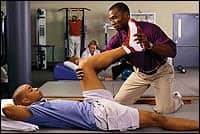 |
Preparing for the grand opening of a new rehabilitation center can be a fun-filled journey, provided you stay focused and true to your plan (which is the backbone of preparation). For a successful plan, consider creating a clinic with your core values, mission, and principles in place. Several stages of development make up that planning, with all major decisions such as equipment purchase, hiring staff, selection of location, and even advertising based on the foundation of your mission and business plan.
STEP ONE: VISION TO MISSION
Your business plan should evolve from the foundations that guide your behavior and your practice. Your vision becomes your mission statement. For example, at The Physical Therapy & Wellness Institute, we accept our mission statement as “To enthusiastically deliver quality-driven physical therapy and quantifiable medically based fitness services to our valuable customers while exceeding their expectations in all areas of the delivery of our services while remaining profitable.” The foundation of a successful practice rests directly on the mission statement. Each and every member of the organization should fully understand the mission of the business, and the principles that guide their behaviors to achieve the company’s mission. Clarity is set once your mission is set, helping you gain focus on the challenges of your business plan.
STEP TWO: ESTABLISHING AN OUTPATIENT CENTER
The process of applying for incorporation, financing, establishing contracts with insurance carriers, establishing adequate insurance coverage, and purchasing equipment is put down on paper as your business plan, serving as your compass for decision making. If you state that you want high-quality care with the most modern equipment in your mission, your decisions on purchase would be different than a mission statement indicating volume of care in a lower socioeconomic area.
Financial viability of the rehabilitation company is at stake from the get-go. Small business is a risk, and more than 20% of all small business start-ups fail after 1 year; more than 50% fail after 5 years. The reasons for failure are well documented, and in our business, the clinical to entrepreneurial transition is the top. Others include lack of experience, poor location, and failure to develop a strategic plan. Once you get past the first 5 years, the chances of survival to the 10-year mark exceed 80%. Fortunately, the outpatient rehabilitation industry will experience continuous growth for many years into the future. Baby Boomers are getting older and are more active; they will require more rehabilitative care, surgery, and help to stay functional. As a result, investors do not consider the business as high risk, especially if the owner has experience in the industry. Consider a small business loan if you want an autonomous business environment; consider investors for larger clinics.
STEP THREE: CHOOSING EQUIPMENT
Often the most daunting decision to make is the equipment purchase. Top of the line equipment will cost you a premium. If your plan is for a small practice in a physician’s office, then small functional equipment such as pulleys, Physioballs, and balance pods, mixed with used or refurbished equipment, may be your best choice. If you are targeting a more affluent population and a stand-alone location, then consider the higher-end equipment, such as medical examination tables, advanced exercise equipment, etc.
At our practice, we chose new bi-angular exercise equipment. We were able to offer great equipment options and flexibility for our PTs and, additionally, created a positive buzz with our physician referrals. As a result, we exceeded our projections of fitness memberships by nearly 50% after our first year.
STEP FOUR: THE MARKETING PLAN
Your vision is coming to fruition. The business plan is done, the financing is set, and the building is established. You should be prepared for the most significant part of the early stages (of your business), which is the promotion of your product, or the marketing plan.
Futurist Faith Popcorn has published several books on the trends in our society, and her vision helped guide our practice with our marketing strategies. As an example, the Popcorn Report lists cocooning, small indulgences, and cashing out as three trends to look for in this decade. She describes cocooning as small groups of people spending a lot more time together (versus mass socialization), small indulgences as an attitude people will have for themselves (because they have earned it), and cashing out as trading the successful life for quality of living (leaving their jobs earlier to take care of their body and minds).
As an example, our plan had to determine exactly who we wanted to be our customers. Decisions needed to be made on HMO contracts, fitness, massage, orthopedic or neurological care, along with many other decisions. HMO contracts were not pursued in exchange for attempting to increase our self-pay programs such as massage, sports training, and medically based exercise programs. Since trends show people were “cashing out” to take care of themselves and were willing to pay more for small indulgences, it became a practical matter to forge ahead with programs designed to increase revenue per visit. When it came to decisions about the interior layout, the theories of cocooning helped us create a place similar to a private home, so our valued customers were able to come to a place where they felt comfortable and safe.
Specifically, the marketing plan should be a group effort with proactive common goals designed to maximize wealth and seek opportunities for relationship building. This document is designed with the idea that the client is first, last, and always in your thoughts. With that in mind, a good place to begin is the four “Ps” of marketing.
1) Product. Each clinic will have to respond to the demands of the valuable customer by altering their product as they grow. Physical therapy itself is not a product, but a service. How you want to deliver this service will determine your “end” product. For instance, if you choose to deliver therapy services with assistants and aides, your end product may dilute. Therefore, your staff hiring is part of your product. We like to hire staff based on a team concept. In other words, two like-minded aggressive physical therapists may not work as well together as one aggressive-minded therapist complemented by a compassionate-thinking therapist. Decisions about your end product include quality, reliability, and features for both your physical and human resources.
2) Price. On paper, price in our industry is simple. You take what they reimburse you. This strategy is directly against the most sophisticated models of business, whereas if you lose pricing, you have no business. Therefore, pricing has to be looked at from the delivery end (salaries), to costs of goods sold, and finally to the price charged. There is no practicality in charging an insurance company more than your contract, but carefully adjusting your charges for any out of pocket programs or goods is necessary, along with determining your cost base for staffing (straight salary versus incentive-based pay), and negotiating reasonable pricing for your purchases.
3) Place. Some describe a “warm home” as a place to visit that feels good to the soul. This feeling is what we wanted to create. Being the first to say “hello” and calling our customers by their first name create our place, along with keeping the lobby free of magazines (only health-related articles and magazines are permitted) and using the walls for a celebration of our customers (their pictures). Some research indicates that it takes 7 seconds for a customer to make a impression, so our “place” must always be clean and inviting, with staff that is smiling and wearing their nametags, and a clinical area that smells fresh, with light music in the background.
4) Promotion. Finally, promotion, which is the act of furthering growth or development, is and always should be in focus. At the physical therapy clinics we manage, we strive to be contagious in our efforts to stay positive, and as a result try to hire enthusiastic, forward-thinking, and positive staff. As a result, the promotion of our product and services becomes secondary, since our customers leave every day feeling good about their experience, helping us spread the word (furthering our growth). Specifically, promotion includes your decisions on advertising, publicity, and promotional products, and your selling strategies. PTs have to sell themselves when they interview for a job, much the way they have to sell their services to a physician when meeting them for lunch. It is a critical process in your business planning. At the onset of your business venture when your budget is tight, you will need to maximize your opportunities for exposure and minimize costs. Consider sending frequent press releases to news media—coverage is never guaranteed, but when you do receive it, it is free and always generates phone calls. Also, community networking is another cost-effective way to spread the word about your business. Join the local chamber of commerce; sign up as a speaker with the local Rotary club; or volunteer at a local senior center. Finally, do some research on which media outlets in your market can deliver the most people for the advertising dollar and advertise there as much as you are able.
STEP FIVE: HELP!
I highly recommend the clinic owner (especially in a start-up facility) become familiar with all areas of business operation. The seven hats you may wear include therapist, aide, scheduler, insurance verification, maintenance, transcriber, and customer service representative. Finally, business is picking up, and the need for help is upon you.
How should you hire a staff? Simply put, hire the right person for the job. We selected only experienced physical therapists during our first 4 years of business, based on the notion we would have to do less training. In all our interviews, role playing is required, giving us a better understanding of how the potential new therapist interacts with physicians and other staff members, as well as how they handle conflict. In addition, all potential candidates are required to work four volunteer hours to determine if we share common values.
SUMMARY
Opening your own outpatient therapy center will likely seem an insurmountable task at times. Broken down into the stages of mission establishment, planning and goal setting, establishing financial viability, choosing equipment, promoting your product, and, finally, hiring staff, this task will become less onerous. Remember, it is your practice. True to your vision, and just like high school, be prepared for an emotional rollercoaster ride. Done correctly, this experience will be just as thrilling and ultimately much more gratifying.
Robert W. Babb, PT, MBA, is the founder and a practicing physical therapist at The Physical Therapy & Wellness Institute, with locations in Lansdale and Quakertown, Pa. He can be reached at .
For more information on setting up a rehabilitation clinic go to the search box at the top of the page and type in “rehabilitation practice management”.





